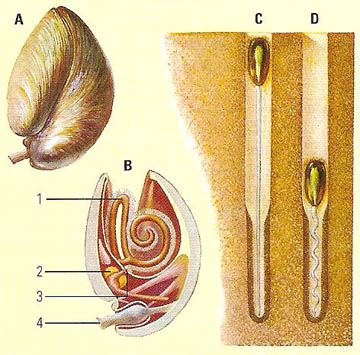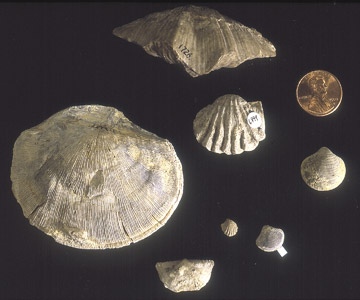brachiopod

A brachiopod comprises a hinged shell and a stalk with which it grips the rocks. The cross-section (B) shows; lophophore (1) which bears ciliated tentacles used for feeding, digestive gland (2), mouth (3), and stalks (4). When feeding Lingula, (C), which resembles fossil forms of 500 million years ago rests on the surface of its burrow using feathery cilia to filter water for food particles, When disturbed, its stalk contracts, drawing the animal into the burrow (D).

A sample of fossil brachiopods found in Kansas.
A brachiopod is any of several hundred species of small, bottom-dwelling, marine invertebrates of the phylum Brachiopoda. Known commonly as lamp-shells, they are similar in outward appearance to bivalve molluscs, having a shell composed of two valves; however, unlike bivalves, they are bilaterally symmetrical – in other words, the right half is a mirror image of the left half (by contrast many bivalves, such as clams, are symmetrical along the line where the valves meet).
Brachiopods live attached to rocks by a stalk or pedicle, or buried in mud or sand. Most modern brachiopods are less than 5 centimeters (2 inches) across. Their shells come in a variety of shapes. Sometimes the bottom valve is convex like the top one, but in many species the bottom valve is concave or occasionally conical. In some brachiopods, the top valve is concave and the bottom is convex. The outer surface of the valves may be marked by concentric wrinkles, radial ribs, and even prominent spines.
At the rear of the animal both valves taper to a beak or umbro. In one group, the valves are calcareous and hinged along the umbo by teeth. The remainder have horny shells joined by muscle alone. In the hinged group, the pedicle cannot pass between the tightly fitting valves and instead leaves through an opening in the umbo of the ventral valve.
The name brachiopod comes from the Latin brachio (arm) and pod (foot), and refers to a paired, internal structure, which scientists initially thought was used for locomotion. This structure, called the lophophore, is actually used for feeding and respiration and is one of the features common to all brachiopods.
Fossil brachiopods
Brachiopods have an extensive fossil record, first appearing in rocks dating back to the early part of the Cambrian Period, about 525 million years ago. They were extremely abundant during the Paleozoic Era, reaching their highest diversity roughly 400 million years ago, during the Devonian Period. At the end of the Paleozoic, however, they were decimated in the mass extinction that marks the end of the Permian Period, about 250 million years ago. This event, known as the Permo-Triassic mass extinction, may have killed more than 90% of all living species, and was the largest of all extinction events (larger than the major extinction at the end of the Cretaceous that killed off the dinosaurs).
Although some brachiopods survived the end-Permian extinction, and their descendants live in today's oceans, they never achieved their former abundance and diversity. Only about 300 to 500 species of brachiopods exist today, a small fraction of the perhaps 15,000 species (living and extinct) that make up the phylum Brachiopoda.


